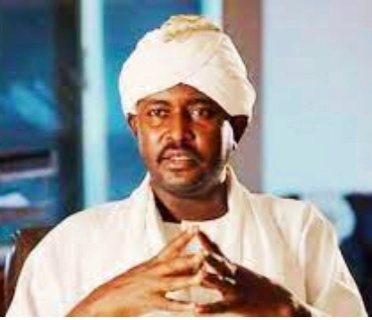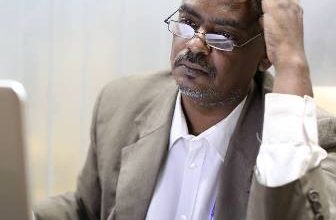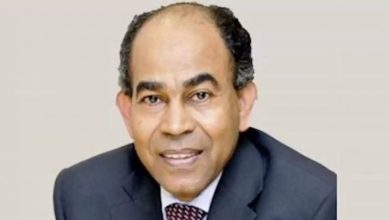From Inside the Celebration: The Devils’ Signing Events

Al-Sadiq Al-Riziqi
Regarding the signing ceremony of what is called the “Founding Charter,” which took place at dawn on Sunday, February 23, 2025, in the Kenyan capital, Nairobi, information has been leaking from within the Rapid Support Forces (RSF) militia and other allied groups collaborating with external parties. A number of activists who were gathered at the event—some angry, others working for different interests—provided detailed accounts of the hours leading up to the signing ceremony, the measures taken inside the hall, and the long meetings that stretched for hours to prevent the signing process from failing or to cover up the disappointments and setbacks that accompanied the event. These details align with leaks from some advisors and close associates of the RSF deputy leader, as well as statements made by signatories who attended as mere ornamental figures in the entire spectacle.
Why were the preparations for the celebration kept secret? Why was an iron curtain drawn around them, barring Kenyan and foreign media from covering the event? The reason was clear: the sharp criticism and intense pressure exerted on the Kenyan government by the opposition, members of parliament, a massive media campaign, and a legal petition submitted to the Supreme Court. As a result, Kenyan authorities requested that the RSF hold the signing ceremony quietly, arranging its location in secret and limiting it to a brief event consisting only of an introduction, songs, and the signing itself, without any speeches.
The venue, The Edge Hotel and Convention Centre, was secured by 200 Kenyan police officers and some plainclothes security personnel. RSF militia members, under the “Security Committee” led by (Musab and Musa A.K.), supervised the entry process, verified attendees’ credentials, matched names against official lists, and ensured no breaches occurred. Media outlets that were not invited were strictly prohibited from entering or even being near the hotel.
The signing ceremony was originally scheduled to begin at 2:00 PM, but it was postponed to 4:00 PM, then 6:00 PM, and eventually stretched until 1:00 AM the following day. Why was there so much delay? According to sources closely involved in the preparations and militia leadership, there were two main reasons. The first was Kenya’s insistence on tightening security measures due to growing internal pressure. The second reason was ongoing negotiations with Abdul Wahid Mohamed Nour, leader of the Sudan Liberation Movement, as well as resistance from Abdel Aziz al-Hilu and his proposed amendments, which he insisted on incorporating. Al-Hilu also refused to sign personally, instead delegating Yusuf Tikka from Blue Nile to sign on behalf of the SPLM-North. This was met with objections from the RSF and its allies, who argued that Yusuf Tikka did not carry enough symbolic weight and that al-Hilu could easily back out of the agreement later. Thus, efforts to persuade al-Hilu and change his stance continued for four hours, from 6:00 PM to 10:00 PM.
Abdul Wahid Mohamed Nour’s position was shaped by his understanding of the political and military landscape in Darfur and its complexities. He had received a warning from his field commander, Yusuf Korgokola, that he would be removed if he signed and allied with the RSF. Additionally, he received angry calls from displaced community leaders in Darfur’s camps, as well as political and foreign advisors who warned that signing would politically ruin him and make him complicit in the RSF’s crimes and violations. As a result, Sultan Ahmed Dinar’s attempts to convince him failed, even with financial incentives. It appears that Abdul Wahid, aiming to consolidate power among the Fur people alone, saw an opportunity in allowing his rivals—Hadi Idris and Ahmed Abdul Shafi (former members of his movement)—to entangle themselves with the RSF, whose hands are stained with blood. However, it is rumored that Abdul Wahid left the door open for a possible future signing and agreed not to oppose or obstruct the charter.
No Kenyan government representative attended the signing ceremony, nor did any foreign dignitary, diplomatic official, or international organization representative. However, it was leaked that former UN Secretary-General envoy Volker Perthes—the man responsible for Sudan’s war—was in Nairobi and met with leaders attending the ceremony. Reportedly, the text of the Founding Charter was written and prepared by Perthes and his associates, then translated into Arabic in coordination with Dr. Nasr al-Din Abdul Bari, Suleiman Sandal, and others from the RSF. Volker was said to have been working behind the scenes.
According to Kenyan sources and diplomatic reports, Shakhbout bin Nahyan, UAE Minister of State for Foreign Affairs and a key figure in the Sudanese file, secretly visited Nairobi. He met with the Kenyan president and his office staff before holding meetings with RSF leaders. A close associate of the RSF deputy leader revealed that the UAE financed this event with $5 million, which was received by Qoni Hamdan and his special committee responsible for funding the event, its preparations, and additional RSF financial needs.
Some tribal administration leaders boycotted the event, while most of those who attended remained at the hotel, expressing great resentment over being ignored and treated poorly. When most of them refused to attend the signing, RSF members—along with Mohamed Hassan Al-Tayashi—engaged in lengthy negotiations to persuade them to delegate Sultan Ahmed Dinar to sign on their behalf, which was ultimately agreed upon. However, dissatisfaction remains.
Only 20 tribal administration leaders attended, including the Nadzir (chief) of the Falata from Tulus, the Nadzir of the Beni Halba, the deputy Nadzir of the Rizeigat, and an Emir from West Darfur. No senior chiefs or tribal leaders from North or Central Darfur attended. The absence of major tribal figures remains one of the biggest challenges facing the charter and its proponents.
It was agreed to establish a special committee that would remain in Nairobi to conduct consultations on forming what is being called the “parallel government” and determining its structure. There is ongoing debate over whether its headquarters should be in Nyala, South Darfur, or Kauda, South Kordofan.
During the signing, some activists were prevented from signing. Taraji Mustafa, who arrived claiming to represent the marginalized groups, was denied the right to sign, leading to heated disputes between her and the event organizers. RSF and political leaders questioned how she was invited and who authorized her attendance, leading to her frustration over being excluded.
Sultan Ahmed Dinar’s companies in Nairobi, Dinar Group and Sultan, managed the logistical aspects, including transportation, hotel bookings, venue arrangements, and local authority coordination. Meanwhile, SARHO, an RSF-affiliated humanitarian organization led by Azaldin Al-Safi and Mohamed Mukhtar, coordinated with international aid organizations such as the World Food Program.
Financial operations were primarily overseen by Qoni Hamdan and Alaa Suleiman, despite the presence of Mustafa Abdul Nabi, the RSF’s financial director and a banking expert in Nairobi. Additionally, RSF advisors played weak roles during the event, even though some had arrived from Dubai as early as February 18, 2025.
Although the families of the RSF leader and his deputy, along with their children and some uncles, were in Nairobi, key figures such as Adel Hamid Dagalo, Musa Hamdan Dagalo, and Juma Hamdan Dagalo were absent.
The biggest question remains: Where is Mohamed Hamdan Dagalo (Hemedti)? Widespread reports claimed he was in Kenya, that he participated in the signing ceremony, and that he held private meetings. However, he was never seen. No one spotted him. His advisors denied his presence altogether.
This absence—combined with the disorganized, hesitant nature of the event—makes the question even more pressing…!



